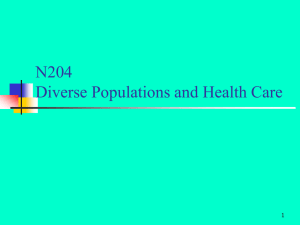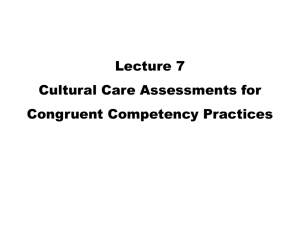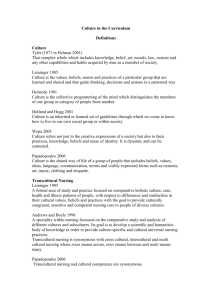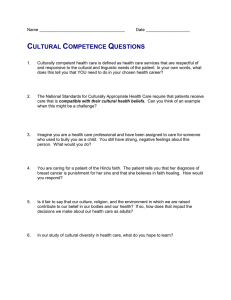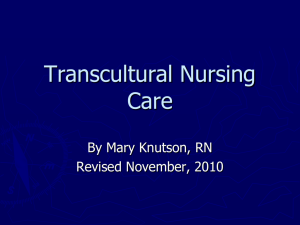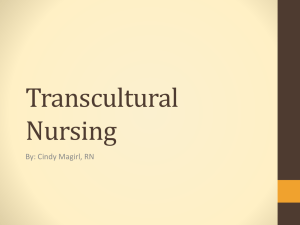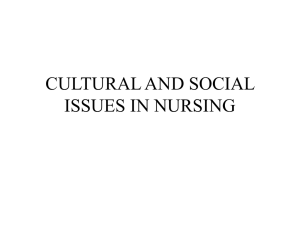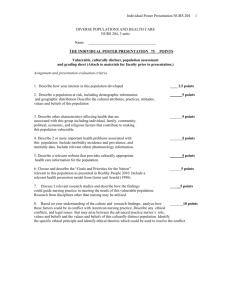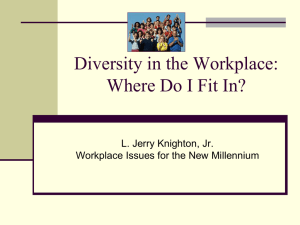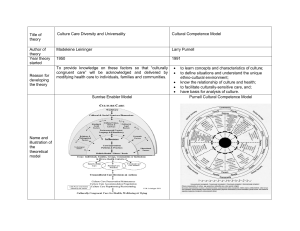Cultural Diversity Training
advertisement
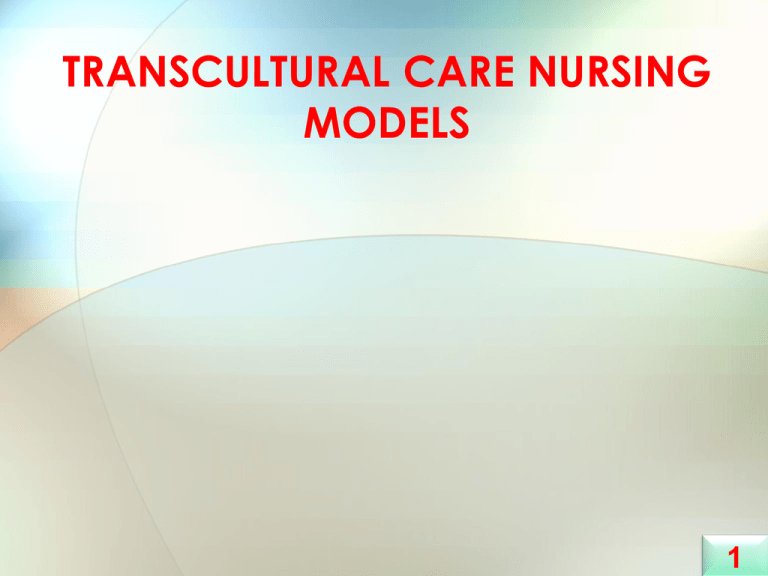
TRANSCULTURAL CARE NURSING MODELS 1 TRANSCULTURAL CARE NURSING MODELS 1. Leininger’s Sunrise Model 2. Purnell’s 3. Giger and Davidhizar’s 2 3 1. LEININGER’S SUNRISE MODEL TO DEPICT THEORY OF CULTURAL CARE DIVERSITY AND UNIVERSALITY Focuses on describing, explaining, and predicting nursing similarities and differences primarily on human care and caring in human cultures. Leininger uses word view, social structure, ethnohistory, environmental context, and the generic (folk) and professional systems to provide a comprehensive and holistic view of influences in culture care and well-being. 4 1. LEININGER’S SUNRISE MODEL Leininger uses word view, social structure, ethnohistory, environmental context, and the generic (folk) and professional systems to provide a comprehensive and holistic view of influences in culture care and well-being. 5 This model emphasizes that health and care are influenced by elements of the social structure, such as technology, religious and philosophic factors, kinship and social systems, cultural values, political and legal factors, economic factors, and educational factors. In order for nurses to assist people of diverse cultures, Leininger presents three intervention modes to demonstrate ways to provide culturally congruent nursing care. These modes are assistive, supportive, facilitative, or enabling professional actions and decisions that help people of a designated culture in: 6 a. Culture care preservation and maintenance – refers to the assistive, supportive, facilitative, or enabling professional actions to retain and/or reserve relevant care values so that they can maintain their well-being, recover from illness, or face handicaps and/or death.” 7 b. Culture care accommodation or negotiation – refers to the assistive, supportive, facilitative, or enabling professional actions to negotiate to /with others for beneficial or satisfying health outcomes with professional care providers.” 8 c. Culture care restructuring and repatterning – refers to the assistive, supportive, facilitative, or enabling professional actions to help a client reorder, change, or greatly modify his or her lifeways for a new, different, and beneficial health care pattern, and maintenance of respect for the client’s cultural values and beliefs while still providing a beneficial or healthier lifeway than before the changes were coestablished with the client. 9 10 2. THE PURNELL MODEL FOR CULTURAL COMPETENCE Macro Aspects of the Model Global society – phenomena related to global society include world communication and politics; conflicts and warfare; natural disasters and famines; international exchanges in education, advances in health sciences, etc. Community – physical, social, and symbolic characteristics that cause people to connect Family – is two or more people who are emotionally connected. Family structure and roles change according to age, generation, marital status, relocation, etc. Person – is a biopsychocultural being who is constantly adapting to his or her environment. 11 The 12 domains essential for assessing the ethnocultural attributes of an individual, family, or group are as follows: 1. 2. 3. 4. 5. 6. 7. 8. 9. 10. 11. 12. Overview, inhabited localities, and topography Communication Family roles and organization Workforce Issues Biocultural ecology High-risk behaviors Nutrition Pregnancy and child-bearing Practices Death rituals Spirituality Health-care practices Health-care practitioners 12 3. THE GIGER AND DAVIDHIZAR’S TRANSCULTURAL ASSESSMENT MODEL 13 The metaparadigm for this model includes: 1. Transcultural nursing and culturally diverse nursing; 2. culturally competent care; 3. culturally unique individuals; 4. culturally sensitive environments; and, 5. health and health status based on culturally specific illness and wellness behavior. 14 The Giger and Davidhizar’s Transcultural Assessment Model Model shows: The client, a unique cultural being, in the center. It is important to remember that the client is culturally unique and as such is a product of past experiences, cultural beliefs and cultural norms. Cultural expressions vary but it is that which give an individual a unique identity. Cultural heritage consistency: This theory analyzes the degree to which people identify with the dominant and traditional cultures . Its essential elements are: culture, ethnicity, and religion 15 1. Culture – represents non-physical traits, such as values, attitudes, beliefs, customs shared by a group of people and passed from generation to the next. Culture is also the sum f beliefs, practices, habits, likes dislikes, norms, customs and rituals learned from the family during the ears of socialization. 16 2. Ethnicity – is a sense of identification associated with a cultural group’s common social and cultural heritage. Ethnicity is indicative of the following characteristics a group may share in some combination: i. Common geographic origin ii. Migratory status iii. Race iv. Language and dialect v. Religious faith or faiths 17 2. Ethnicity – cont… vi. Ties that transcend kinship, neighborhood, and community boundaries vii. Shared traditions, values, and symbols viii. Literature, folklore, and music ix. Food preferences x. Settlement and employment patterns xi. Special interest with regard to politics in the homeland and in the United States xii. Institutions that specifically serve and maintain the group 18 Religion – “the belief in a divine or superhuman power or powers to be obeyed and worshipped as the creator(s) and ruler (s) of the universe; and a system of beliefs, practices and ethical values. It is not possible to isolate the aspects of culture religion, and ethnicity that shape a person’s worldview. Each is a part of the other, and all three are united within the person. Therefore, when religion is discussed, culture and ethnicity must also be included. 19 The Six Cultural Organizing Phenomena 20 Culturally diverse nursing must take into account six cultural phenomena that vary but are evident in all cultural groups and affect health care. These have been identified by Giger & Davidhizar, 1999, and Engebertson & Headley(2000), as: (1)environmental control, (2)biological variations, (3)social organization (4)Communication, (5)space, and (6)time orientation. 21 1. ENVIRONMENTAL CONTROL – refers to the ability of members of a particular group to plan activities that control nature or direct environmental factors. Plays an extremely important role in the way patients respond to health-related experiences, including the ways in which they define health and illness and seek and use health care resources and social supports. Examples of environmental control systems: complex traditional health and illness beliefs, the practice of folk medicine, the use of traditional healers, etc. 22 2. BIOLOGICAL VARIATIONS – The several ways in which people from one cultural group differ biologically (i.e., physically and genetically) from other cultural groups constitute their biological variations. These are: Body built and structure – specific bone structure and structural differences between groups. Example: smaller stature of Asians Skin color, including variations in tone, texture, healing abilities, and hair follicles. Example: African Americans – dark skinned; Europeans – light skinned Jewish and Islamic Americans, etc. Common nutritional disorder, lactose intolerance, is found among Mexicans. Africa, Asian, and Eastern European Jewish Americans 23 3. SOCIAL ORGANIZATION – refers to the ways in which groups determine rules of acceptable behavior and role of individual members. Family unit (nuclear, single parent, extended, blended) Children learn their cultural responses to life events from the family and its ethnoreligious group through socialization. Gender – gender roles vary according to cultural context: patriarchal structure – husband/father is the dominant person (Latino, Hispanic and traditional Muslim families matriarchal structure – the wife is responsible for child care and household maintenance whereas the father’s role is to support and protect the family members. Lifestyle – alternative lifestyles. Example: homosexual couples and communal groups 24 Social organization also prescribes behavior for such significant events as birth, death, child rearing, and illness. Nurses must demonstrate respect for client’s lifestyles even when they differ from theirs by: Being aware of own tendency to be ethnocentric Being sensitive to client’s needs especially those expressed non-verbally Use self-awareness to determine the impact of own beliefs and values 25 4. SPACE (PROXEMICS) – The area around a person’s body, surrounding environment, and objects within that environment; affects people’s behaviors and attitudes toward the space around themselves. Territoriality refers to the behavior and attitude people exhibit about an area they have claimed and defend or react emotionally when others encroach on it. Both personal space and territoriality are influenced by culture, thus different ethnocultural groups have varying norms related to the use of space. 26 Space and related behaviors have different meanings in the following zones: Intimate zone – extends up to 1 ½ feet. Acceptable only in private places because this distance allows adults to have the most bodily contact for perception of breath and odor, Personal distance – extends from 1 ½ to 4 feet. This is an extension of the self that is like a “bubble” of space surrounding the body. At this distance the voice may be moderate, body odor may not be apparent, and visual distortion may have disappeared. 27 Social distance – extends from 4 to 12 feet. This is reserved for impersonal business transactions. Perceptual information is much less detailed. Public distance – extends 12 feet or more. Individuals interact only impersonally. Communicator’s voices must be projected, and subtle facial expressions may be lost. Use of personal space varies among individuals and ethnic groups. The extreme modesty practiced by members of some cultural groups may prevent members from seeking preventive health care. 28 5. Time Orientation (Temporal Relationships) – refers to viewing of time in the present, past or future; varies among different cultural groups. Most cultures include all three time orientation, but one orientation is more likely to dominate the cultural perspective. Examples: American culture – future oriented; time is a highly valuable resource: do not waste time, “time is money” German culture – past-oriented society, where laying a proper foundation by providing historical background information can enhance communication Central American culture – present oriented Asian, Latin countries – punctuality is not taken seriously 29 Communication – Language differences possibly play the most important obstacle to providing multicultural health care because clients come from all over the world and they affect all stages of the patient caregiver relationship. to, and evaluate our experience. 30 31 THANK YOU 32
